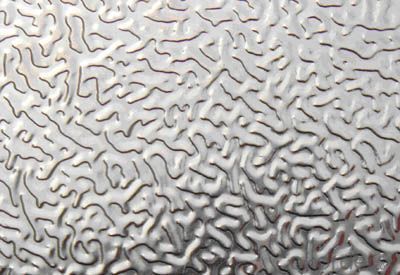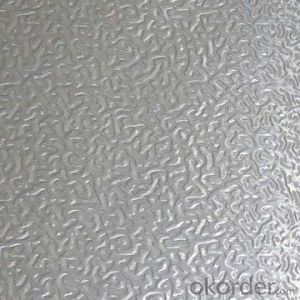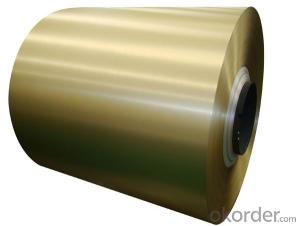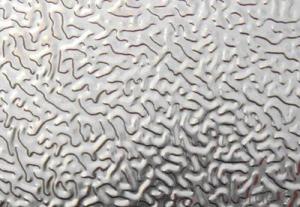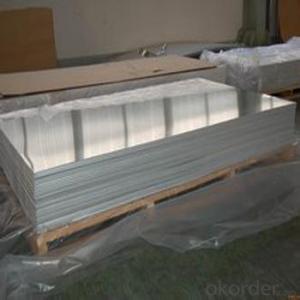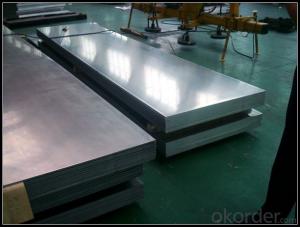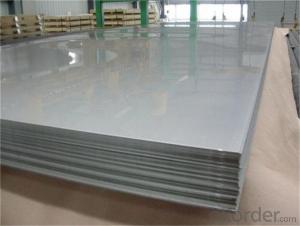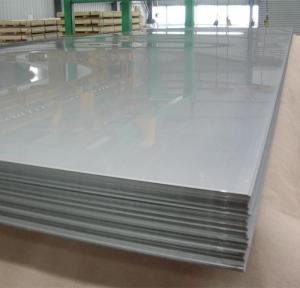Aluminum Sheets in West Virginia with a Wide Range of Properties - Embossed Aluminum Sheets
- Loading Port:
- Shanghai
- Payment Terms:
- TT OR LC
- Min Order Qty:
- 5 m.t.
- Supply Capability:
- 5000 m.t./month
OKorder Service Pledge
OKorder Financial Service
You Might Also Like
Aluminium alloys with a wide range of properties are used in engineering structures. Alloy systems are classified by a number system (ANSI) or by names indicating their main alloying constituents (DIN and ISO).
The strength and durability of aluminium alloys vary widely, not only as a result of the components of the specific alloy, but also as a result of heat treatments and manufacturing processes. A lack of knowledge of these aspects has from time to time led to improperly designed structures and gained aluminium a bad reputation.
One important structural limitation of aluminium alloys is their fatigue strength. Unlike steels, aluminium alloys have no well-defined fatigue limit, meaning that fatigue failure eventually occurs, under even very small cyclic loadings. This implies that engineers must assess these loads and design for a fixed life rather than an infinite life.
Another important property of aluminium alloys is their sensitivity to heat. Workshop procedures involving heating are complicated by the fact that aluminium, unlike steel, melts without first glowing red. Forming operations where a blow torch is used therefore require some expertise, since no visual signs reveal how close the material is to melting. Aluminium alloys, like all structural alloys, also are subject to internal stresses following heating operations such as welding and casting. The problem with aluminium alloys in this regard is their low melting point, which make them more susceptible to distortions from thermally induced stress relief. Controlled stress relief can be done during manufacturing by heat-treating the parts in an oven, followed by gradual cooling—in effect annealing the stresses.
The low melting point of aluminium alloys has not precluded their use in rocketry; even for use in constructing combustion chambers where gases can reach 3500 K. The Agena upper stage engine used a regeneratively cooled aluminium design for some parts of the nozzle, including the thermally critical throat region.
Another alloy of some value is aluminium bronze (Cu-Al alloy).
We provide a full range of precision aluminum strip for almost any application. We produce aluminum strip in a wide variety of alloys, including clad composites. Our aluminum strip can be produced in standard dimensions or custom made to your special requirements. We produce both imperial and metric units. We manufacture in compliance with the main international specifications, and tighter tolerances or custom tempers are available upon request. We offer various surface conditions, custom finishes (painting, anodizing, embossing), special processing, and multiple packaging options to meet our customer's unique requirements. The following is a summary of our capabilities.
Manufactured in compliance with the main international specifications and standards, including: Aluminum Association, ASTM, EN, and DIN.
We can also manufacture in compliance with other international standards including:ASME, SAE, AMS, AWS, FED, MIL, QQ, ISO, BS, AFNOR, JIS and GOST.
Manufactured in compliance with the main international specifications and standards.
Tighter tolerances are available upon request.
Aluminium (or aluminum; see spelling differences) is a chemical element in the boron group with symbol Al and atomic number 13. It is a silvery white, soft, ductile metal. Aluminium is the third most abundant element (after oxygen and silicon), and the most abundant metal in the Earth's crust. It makes up about 8% by weight of the Earth's solid surface. Aluminium metal is so chemically reactive that native specimens are rare and limited to extreme reducing environments. Instead, it is found combined in over 270 different minerals.The chief ore of aluminium is bauxite.
Aluminium is remarkable for the metal's low density and for its ability to resist corrosion due to the phenomenon of passivation. Structural components made from aluminium and its alloys are vital to the aerospace industry and are important in other areas of transportation and structural materials. The most useful compounds of aluminium, at least on a weight basis, are the oxides and sulfates.
Despite its prevalence in the environment, no known form of life uses aluminium salts metabolically. In keeping with its pervasiveness, aluminium is well tolerated by plants and animals. Owing to their prevalence, potential beneficial (or otherwise) biological roles of aluminium compounds are of continuing interest.
The earliest citation given in the Oxford English Dictionary for any word used as a name for this element is alumium, which British chemist and inventor Humphry Davy employed in 1808 for the metal he was trying to isolate electrolytically from the mineral alumina. The citation is from the journal Philosophical Transactions of the Royal Society of London: "Had I been so fortunate as to have obtained more certain evidences on this subject, and to have procured the metallic substances I was in search of, I should have proposed for them the names of silicium, alumium, zirconium, and glucium."
Davy settled on aluminum by the time he published his 1812 book Chemical Philosophy: "This substance appears to contain a peculiar metal, but as yet Aluminum has not been obtained in a perfectly free state, though alloys of it with other metalline substances have been procured sufficiently distinct to indicate the probable nature of alumina."[69] But the same year, an anonymous contributor to the Quarterly Review, a British political-literary journal, in a review of Davy's book, objected to aluminum and proposed the name aluminium, "for so we shall take the liberty of writing the word, in preference to aluminum, which has a less classical sound."
The -ium suffix conformed to the precedent set in other newly discovered elements of the time: potassium, sodium, magnesium, calcium, and strontium (all of which Davy isolated himself). Nevertheless, -um spellings for elements were not unknown at the time, as for example platinum, known to Europeans since the 16th century, molybdenum, discovered in 1778, and tantalum, discovered in 1802. The -um suffix is consistent with the universal spelling alumina for the oxide (as opposed to aluminia), as lanthana is the oxide of lanthanum, and magnesia, ceria, and thoria are the oxides of magnesium, cerium, and thorium respectively.
The aluminum spelling is used in the Webster's Dictionary of 1828. In his advertising handbill for his new electrolytic method of producing the metal in 1892, Charles Martin Hall used the -um spelling, despite his constant use of the -ium spelling in all the patents[58] he filed between 1886 and 1903. It has consequently been suggested[by whom?] that the spelling reflects an easier-to-pronounce word with one fewer syllable, or that the spelling on the flyer was a mistake.[citation needed] Hall's domination of production of the metal ensured that aluminum became the standard English spelling in North America.
- Q: How do aluminum sheets perform in extreme temperatures?
- Aluminum sheets are known for their excellent performance in extreme temperatures. Aluminum has a high melting point, around 660 degrees Celsius, which makes it capable of withstanding high temperatures without deforming or melting. In extreme heat, aluminum sheets have a low thermal expansion rate, meaning they will not expand or contract significantly, ensuring dimensional stability. This makes them ideal for applications in industries such as aerospace, automotive, and construction, where extreme temperatures are common. Similarly, in extremely cold temperatures, aluminum sheets retain their strength and durability, unlike some other metals that become brittle and prone to cracking. Additionally, aluminum has excellent thermal conductivity, allowing it to distribute heat evenly, which is beneficial in applications where heat dissipation is crucial. Overall, aluminum sheets perform exceptionally well in extreme temperatures, making them a reliable choice for various industries.
- Q: How do aluminum sheets perform in terms of thermal insulation?
- Aluminum sheets are not effective in terms of thermal insulation. Due to their high thermal conductivity, aluminum sheets allow heat to easily transfer through them. This means that they are not able to effectively block or resist the transfer of heat, resulting in poor thermal insulation properties. If thermal insulation is the primary concern, other materials such as fiberglass, foam, or mineral wool would be more suitable choices.
- Q: Can aluminum sheets be powder-coated?
- Indeed, aluminum sheets undergo powder coating, a procedure involving the electrostatic application of dry, powdered paint onto a surface. Subsequently, the coated aluminum is subjected to heat curing, resulting in a robust and visually appealing finish. Aluminum is particularly well-suited for powder coating due to its lightweight nature and resistance to corrosion. The powder coating firmly attaches to the aluminum surface, creating a protective layer that enhances the sheet's aesthetic appeal while offering enduring safeguard against deterioration.
- Q: What are the different methods of surface cleaning for aluminum sheets?
- There are several methods of surface cleaning for aluminum sheets, each with its own advantages and suitability for different types of cleaning needs. 1. Mechanical Cleaning: This method involves using mechanical abrasion techniques to remove dirt, stains, and oxidation from the surface of aluminum sheets. It can be done using brushes, abrasive pads, sandpaper, or a wire brush. Mechanical cleaning is effective for removing heavy dirt or oxidation, but it may leave scratches on the surface if not done carefully. 2. Chemical Cleaning: Chemical cleaning involves the use of specific cleaning agents or solutions that are designed to dissolve or remove dirt, grease, oil, or other contaminants from aluminum surfaces. These cleaning agents can vary depending on the type of dirt or stain being removed. For example, alkaline cleaners are effective for removing oil and grease, while acidic cleaners can remove mineral deposits or oxidation. It is important to follow the manufacturer's instructions and safety precautions when using chemical cleaners. 3. High-Pressure Water Cleaning: This method utilizes a high-pressure water jet to clean the aluminum surface. The force of the water helps to dislodge dirt or grime from the sheet. High-pressure water cleaning is particularly useful for removing loose debris or light dirt from larger areas. However, it may not be suitable for heavily soiled or oxidized surfaces. 4. Steam Cleaning: Steam cleaning involves using high-temperature steam to remove dirt, grime, or other contaminants from aluminum sheets. The steam helps to loosen the dirt, making it easier to wipe or rinse away. Steam cleaning is effective for removing grease, oil, or other stubborn stains. It is a versatile method that can be used on both small and large surfaces. 5. Electrolytic Cleaning: Electrolytic cleaning is a specialized method that uses an electric current to remove contaminants from the aluminum surface. The aluminum sheet is immersed in a cleaning solution, and an electric current is passed through it. This causes the contaminants to be attracted to a sacrificial electrode, leaving the aluminum sheet clean. Electrolytic cleaning is effective for removing heavy oxidation or corrosion, but it requires specialized equipment and expertise. It is important to consider the specific cleaning requirements, the condition of the aluminum sheet, and the desired level of cleanliness when choosing the appropriate method of surface cleaning. It is also advisable to test the chosen method on a small, inconspicuous area first to ensure compatibility and avoid any potential damage to the aluminum sheet.
- Q: Can aluminum sheets be reused or recycled after their initial use?
- <p>Yes, aluminum sheets can be recycled again after use. Aluminum is one of the most recycled materials globally due to its low cost of recycling and its ability to retain its properties even after multiple recycling processes. Recycling aluminum saves energy compared to producing new aluminum from raw materials, and it helps reduce waste in landfills.</p>
- Q: What are the methods used to treat the surface of aluminum sheets to improve their properties or appearance?
- <p>Surface treatment of aluminum sheets involves various processes to enhance their properties or appearance. These include anodizing, which creates a protective oxide layer; painting, which provides a decorative and protective coating; powder coating, a durable and corrosion-resistant method; polishing, which gives a shiny finish; and etching, which creates decorative patterns. Other treatments include chemical conversion coatings, such as chromate and phosphate, for corrosion resistance, and thermal spraying for wear resistance. Each method serves a specific purpose, from improving durability to aesthetic enhancement.</p>
- Q: What advantages does the ceramic panel curtain wall have compared with the aluminum sheet and stone curtain wall?
- The color of aluminum sheet is single, the quality is not high; the price of stone is high; the color difference is serious; the radiation is not environmental; and the resource is limited; the supply is difficult to guarantee; the weight of the tile is light; the radiation is zero; the pollution resistance is strong. Rich in color, especially in the production process, forms of diversification, to meet high, medium and low-end customer base needs. Zhejiang ruigao company is China and Asia's first introduction of the ceramic plate production line, their R & D capability is recognized. The pursuit of perfection, the introduction of new ideas, and the concept of customization for architects to realize their dreams and fashion designs for the architecture have opened wider space for the wide application of ceramic panels and curtain walls. In fact, the application of ceramic is not limited to curtain wall, but also applied to the lighting effect display, interior decoration and so on. Hi! In short, there are any problems can be exchanged with each other.
- Q: I want to make a dress from aluminum cans. However, aluminum is very sharp once cut. So, do you thing there is a possible way to make the cut edges less sharp? Would sanding the edges help?
- It's a soft metal so sanding and filing would work. You could also consider folding over the sharp edges (like a hemline) using a pliers or similar tool
- Q: Can aluminum sheet be used for architectural façade systems?
- Indeed, architectural façade systems can make use of aluminum sheet. The lightweight, durable, and corrosion-resistant properties of aluminum make it a favored option for building exteriors. It can be easily manipulated and fabricated into a plethora of shapes and sizes, thus rendering it suitable for the creation of intricate designs and architectural elements. Moreover, aluminum can be coated or treated in various ways to enhance its appearance and shield it from weathering. The versatility, aesthetic appeal, and long-term cost-effectiveness of aluminum sheet make it an exceptional selection for architectural façade systems.
- Q: Are the aluminum sheets suitable for decorative purposes?
- Yes, aluminum sheets are suitable for decorative purposes. They offer a sleek and modern look, are lightweight, durable, and versatile, making them an ideal choice for various decorative applications such as wall panels, signage, ceilings, and furniture. Additionally, aluminum sheets can be easily customized, painted, or engraved to create unique and visually appealing designs.
Send your message to us
Aluminum Sheets in West Virginia with a Wide Range of Properties - Embossed Aluminum Sheets
- Loading Port:
- Shanghai
- Payment Terms:
- TT OR LC
- Min Order Qty:
- 5 m.t.
- Supply Capability:
- 5000 m.t./month
OKorder Service Pledge
OKorder Financial Service
Similar products
Hot products
Hot Searches
Related keywords




